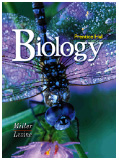BIOLOGY
by Miller & Levine
[complete Table of Contents]

|
Use the pull-down menu to jump to any of the Book's 40 Chapters: |
Additional Resources:
Animal
Diversity Web
An extraordinary site from the University
of Michigan
The
Ocean Planet
An exhibition about our planet and its oceans, sponsored by NASA
Texas
Parks and Wildlife
Extensive information about Texas wildlife and natural regions of the
state.

In this chapter, students will will read about how the biologists called ecologists study the relationships among organisms in the living part of the Earth's environment, called the biosphere. You will also discover how energy and nutrients flow through the biosphere The links below lead to additional resources to help you with this chapter. These include Hot Links to Web sites related to the topics in this chapter, the Take It to the Net activities referred to in your textbook, a Self-Test you can use to test your knowledge of this chapter, and Teaching Links that instructors may find useful for their students.
| Hot Links | Take it to the Net |
| Chapter Self-Test | Teaching Links |
What are Web Codes? |
Web
Codes for Chapter 3: Active Art: The Water Cycle Miller & Levine: Exploring Ecology from Space SciLinks: Energy Pyramids SciLinks: Cycles of Matter Self-Test |
![]()
Section 3-1: What
Is Ecology?
![]() To understand
the various relationships within the biosphere, ecologists ask questions
about events and organisms that range in complexity from a single individual
to a population, community, ecosystem, or biome, or to the entire biosphere.
To understand
the various relationships within the biosphere, ecologists ask questions
about events and organisms that range in complexity from a single individual
to a population, community, ecosystem, or biome, or to the entire biosphere.
![]() Scientists conduct
modern ecological research according to three basic approaches: observing,
experimenting, and modeling. All of these approaches rely on the application
of scientific methods to guide ecological inquiry.
Scientists conduct
modern ecological research according to three basic approaches: observing,
experimenting, and modeling. All of these approaches rely on the application
of scientific methods to guide ecological inquiry.
Section 3-2: Energy Flow
 Sunlight is the main energy source for
life on Earth. In a few ecosystems, some organisms rely on the energy
stored in inorganic chemical compounds.
Sunlight is the main energy source for
life on Earth. In a few ecosystems, some organisms rely on the energy
stored in inorganic chemical compounds.
 Energy flows through an ecosystem in
one direction, from the sun or inorganic compounds to autotrophs (producers)
and then to various heterotrophs (consumers).
Energy flows through an ecosystem in
one direction, from the sun or inorganic compounds to autotrophs (producers)
and then to various heterotrophs (consumers).
 Only about 10 percent of the energy available
within one trophic level is transferred to organisms at the next trophic
level.
Only about 10 percent of the energy available
within one trophic level is transferred to organisms at the next trophic
level.
Section 3-3: Cycles of Matter
 Unlike the one-way flow of energy, matter
is recycled within and between ecosystems.
Unlike the one-way flow of energy, matter
is recycled within and between ecosystems.
 Every living organism needs nutrients
to build tissues and carry out essential life functions. Like water, nutrients
are passed between organisms and the environment through biogeochemical
cycles.
Every living organism needs nutrients
to build tissues and carry out essential life functions. Like water, nutrients
are passed between organisms and the environment through biogeochemical
cycles.